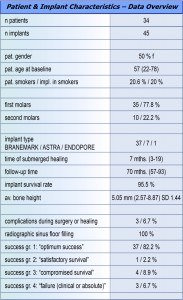Über den Autor
Co-Autoren
Dr. Frank Brösler, Dr. Christina Tietmann, I. Mizani
A long-term retrospective analysis of osteotome sinus floor elevation and simultaneous implant placement
Thema
Background
20 years after Summers’ first description of the transalveolar osteotome technique in the posterior maxilla this procedure has been established as a standard method for sinus floor elevation. Minimized post-operative morbidity, reduced treatment time and less patient expenses have been described as advantages compared to the more invasive lateral window approach.
Material and Methods
45 implants were placed in molar sites with reduced bone height utilizing the osteotome technique with simultaneous augmentation with deproteinized bovine bone mineral (DBBM). After a minimum of 12 weeks of submerged healing implants were loaded with cemented crowns supported by customized abutments. All patients were followed up clinically and radiographically over more than 5 years. All patients had given informed consent for study participation.
Radiographs were analysed at implant placement and after at least 5 years of loading. Digitized radiographs were assessed by 2 blinded examiners, residual bone height was measured on mesial and distal aspects of each implant at insertion time by ImageJ Software (National Institutes of Health, USA). Radiographic standardization was performed by means of implant length. Success criteria are as described by Misch et al., 2008.
 Patient & Implant Characteristics – Data Overview
Patient & Implant Characteristics – Data Overview
Results
Of the 45 implants, 2 (4.5 %) were lost and 1 (2.2 %) was a clinical failure, while 37 (82.2 %) were in “optimum functional and esthetic condition”. 100% of the implant sites with functioning fixtures showed complete radiographic opacity in the formerly augmented sinus areas. The residual bone height at implant placement was on average 5,05 mm (2.57-8.87). Bone height increased significantly over the follow up period (p < 0.05). Therapeutic failure was associated with lack of primary stability at time of placement and wound healing complications.
Bildergalerie (4)
Literatur:
- Summers, Robert B. 1994. "A new concept in maxillary implant surgery: the osteotome technique." Compendium 15 (2) : 152-160.
- Pjetursson, Bjarni E./Niklaus P. Lang. 2014. "Sinus floor elevation utilizing the transalveolar approach." Periodontology 2000. 66 (1): 59-71.
-
Carl E. Misch/Morton L. Perel/Hom-Lay Wang/Gilberto Sammartino/Pablo Galindo-Moreno/Paolo Trisi/Marius Steigmann/Alberto Rebaudi/Ady Palti/Michael A. Pikos/D. Schwartz-Arad/Joseph Choukroun/Jose-Luis Gutierrez-Perez/Gaetano Marenzi/Dimosthenis K. Valavanis. 2008. "Implant success, survival, and failure: the International Congress of Oral Implantologists (ICOI) Pisa Consensus Conference." Implant Dentistry 17 (1): 5-15.
Zusammenfassung:
Transalveolar sinus floor elevation utilizing grafting material has shown a successful long-term outcome. The treatment is a predictable way to achieve good functional and esthetic results.




